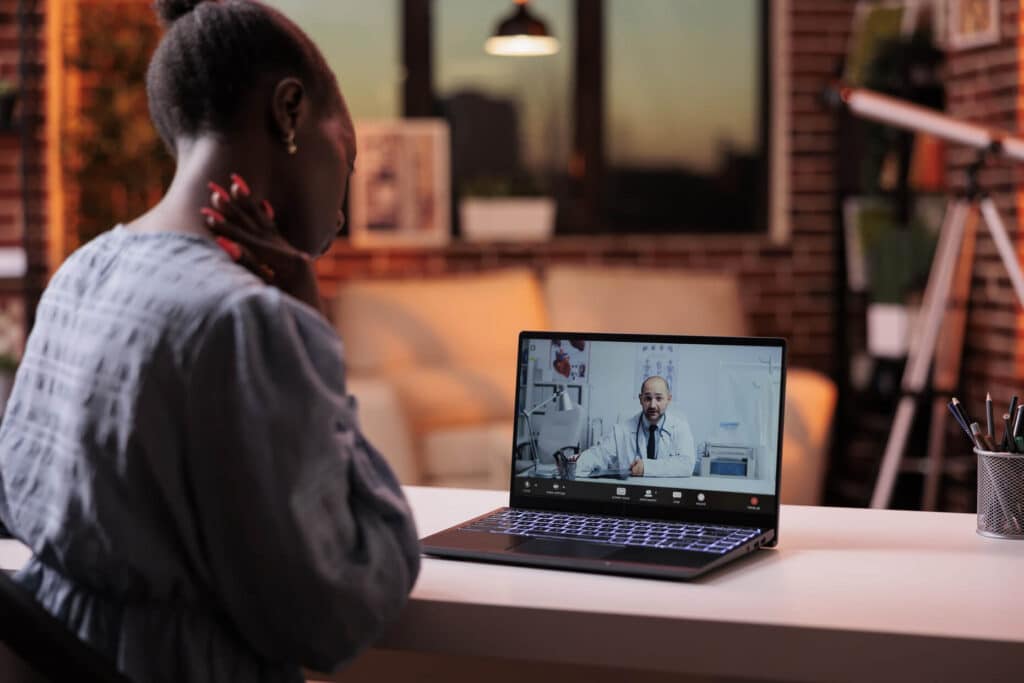Thanks to the advancement of technology, healthcare is changing rapidly.
Telehealth is one of the most innovative and disruptive trends in healthcare today.
Not too sure what telehealth is? Don’t worry, we cover that.
In this blog post, we will explore the basics of telehealth, including what it is, the history of telehealth, how it works, and the benefits it offers. We will also explain telehealth vs telemedicine, and so much more.
So, what are you waiting for?

What is telehealth?
Telehealth is when you get healthcare services from a doctor or other healthcare provider without having to go to their office. You can use a computer, tablet, or smartphone to talk to your provider, or you can send and receive messages. Telehealth can be used for a variety of things, including appointments, consultations, and monitoring your health.
How telehealth has evolved.
Telehealth has come a long way since its early beginnings in the late 19th century.
Early experiments with telephone and radio transmission were limited by technological constraints, but the 1970s saw the launch of NASA’s STARPAHC project, which used satellite communication to provide healthcare to remote areas.
As technology continued to advance, telehealth services evolved alongside it, with the growth of the internet, high-speed data connections, and sophisticated digital devices paving the way for real-time video consultations, remote patient monitoring, and electronic health records.
Today’s telehealth landscape.
Today, telemedicine and telehealth are no longer niche concepts – they’re mainstream pillars of healthcare. From virtual doctor appointments and mental health therapy sessions conducted through secure video calls to wearable devices that transmit real-time health data to medical professionals, the possibilities are staggering. The COVID-19 pandemic further accelerated the adoption of telemedicine, highlighting its indispensable role in ensuring continuous medical care while minimizing physical contact.

Telehealth vs telemedicine: What’s the difference?
Telehealth and telemedicine are two terms that are often used interchangeably, but they have different meanings. Telemedicine is the use of technology to provide medical consultations remotely, while telehealth is a broader term that encompasses a wider range of healthcare services, including health education, remote patient monitoring, and administrative tasks.
Telemedicine:
Telemedicine is a way to get medical care from a doctor or other healthcare provider remotely. You can use a computer, tablet, or smartphone to talk to your provider, or you can send and receive messages. Telemedicine is ideal for addressing minor illnesses, discussing treatment plans, reviewing test results, and managing chronic conditions without the need for in-person visits.
Telehealth:
Telehealth is a broader term that encompasses a wider range of healthcare services than telemedicine. Telehealth includes services like health education, remote patient monitoring, and administrative tasks like scheduling telehealth appointments and managing prescriptions. It’s a holistic approach to healthcare that leverages technology to enhance every aspect of the patient journey, from prevention and diagnosis to treatment and ongoing care.
Basically telemedicine is like a virtual doctor’s office, and telehealth is a digital healthcare ecosystem that covers various aspects of your well-being. Both telehealth and telemedicine are making healthcare more accessible, convenient, and patient-centric than ever before.

What can you do with telehealth?
The possibilities with telehealth are endless. Obviously as technology continues to advance, the scope of telehealth services will only expand, bringing healthcare closer to everyone, regardless of their location or circumstances.
Here are some of the things you can do through telehealth:
- Virtual doctor’s visits: Talk to a doctor online for diagnosis through a telehealth appointment, treatment plans, and medical advice.
- Prescription refills: Get prescriptions renewed and get medication recommendations through video calls.
- Mental health support: Access therapy sessions, counseling, and mental health resources from home.
- Chronic disease management: Get ongoing care, guidance, and monitoring for chronic conditions through remote consultations.
- Follow-up appointments: Conduct follow-up visits via video calls for post-treatment check-ins.
- Specialist consultations: Connect with specialists across different fields to receive expert advice.
- Health education: Attend webinars, workshops, and online classes to learn about health, wellness, and preventive measures.
- Wellness coaching: Get personalized guidance on fitness, nutrition, and lifestyle choices to improve your overall well-being.
- Remote patient monitoring: Use wearable devices to track vital signs and health metrics, and share data with your healthcare provider.
- Second opinions: Get alternative medical opinions from experts around the world without traveling long distances.
- Preventive care: Receive recommendations for screenings, vaccinations, and health screenings to catch issues early.
- Post-operative care: Stay connected with your healthcare team after surgery to ensure a smooth recovery process.
- Pediatric care: Consult with pediatricians about your child’s health, growth, and development milestones.
- Urgent care: Address non-life-threatening emergencies through telehealth platforms, saving time and avoiding crowded ERs.
- Nutritional guidance: Work with dietitians to create personalized meal plans and address dietary concerns.
- Physical therapy: Engage in virtual physical therapy sessions to rehabilitate injuries and improve mobility.
- Speech and language therapy: Access speech therapy sessions for speech disorders, language development, and more.
- Prenatal care: Receive prenatal check-ups, maternal education, and support during pregnancy through telehealth.
- Elderly care: Provide seniors with remote healthcare options, reducing the need for travel and exposure to illness.

What medical specialties can you use via telehealth services?
The great thing about telehealth services, is you can remotely access healthcare professionals in a wide range of medical specialties. Some of the specialties you can use through telehealth include:
- Primary care: For general health concerns, routine check-ups, and preventive care.
- Internal medicine: Addressing adult health issues, chronic conditions, and disease management.
- Pediatrics: Consult pediatricians for child health, developmental milestones, and parenting advice.
- Dermatology: Diagnosing and treating skin conditions, rashes, and minor dermatological issues.
- Psychiatry and psychology: Receiving mental health counseling, therapy from telehealth therapists, and medication management.
- Cardiology: Managing heart health, hypertension, and cardiac conditions.
- Endocrinology: Treating hormonal imbalances, diabetes, and thyroid disorders.
- Gastroenterology: Addressing digestive issues, gastrointestinal diseases, and nutritional concerns.
- Orthopedics: Consult orthopedic specialists for musculoskeletal injuries and joint problems.
- Obstetrics and gynecology: Discussing women’s health, prenatal care, and reproductive concerns.
- Ophthalmology: Evaluating eye conditions, vision problems, and eye health.
- Urology: Managing urinary tract problems, urological conditions, and kidney health.
- Neurology: Consultations for neurological issues, headaches, and nervous system disorders.
- Physical therapy: Receiving guidance and exercises for rehabilitation and mobility improvement.
- Speech therapy: Addressing speech and language disorders through virtual sessions.
- Nutrition and dietetics: Creating personalized diet plans and addressing nutritional concerns.
- Allergies and immunology: Discussing allergies, immune system issues, and treatment plans.
- Rheumatology: Treating autoimmune diseases, arthritis, and joint inflammation.
- Infectious diseases: Managing infectious conditions and seeking expert advice during outbreaks.
- Pulmonology: Evaluating respiratory issues, asthma, and lung health.
- Otolaryngology (ENT): Addressing ear, nose, and throat conditions through virtual consultations.
- Oncology: Discussing cancer treatment options, follow-ups, and support.
- Radiology: Reviewing imaging results and discussing diagnostic procedures.
The scope of telehealth is continually expanding, encompassing an array of medical specialties, ensuring that patients can receive specialized care without the need for in-person visits.
Benefits of using telehealth
Naturally, telehealth’s many benefits make it a valuable tool for patients and providers alike.
Here are some of the benefits telehealth offers:
- Convenience: Get healthcare services from home, without having to travel or wait in long lines.
- Accessibility: Reach healthcare professionals regardless of your location.
- Time savings: Save time by avoiding commutes, waiting rooms, and time off from work.
- Flexible scheduling: Schedule appointments that fit your busy schedule.
- Reduced costs: Cut down on transportation and childcare costs.
- Continuity of care: Maintain consistent medical care, even if you’re traveling or live in a rural area.
- Remote monitoring: Stay connected with your healthcare provider through remote monitoring devices.
- Privacy: Discuss sensitive health matters in the privacy of your own home.
- Lower infection risk: Minimize your exposure to contagious illnesses.
- Quick response: Get prompt medical attention for urgent but non-emergency concerns.
- Specialist access: Easily consult with specialists who might be located far away or have long waiting lists.
- Parental convenience: Access pediatric care for your children without having to take them to a clinic.
- Increased engagement: Take an active role in your own health management and decisions.
- Digital records: Maintain electronic health records, reducing the risk of paperwork errors and loss of information.
- Empowering rural areas: Bring advanced medical expertise to remote and underserved communities.
- Environmentally friendly: Reduce your carbon footprint by minimizing travel-related emissions for medical visits.
It is a convenient, accessible, and affordable way to get the healthcare you need. As technology continues to advance, telehealth is likely to play an even greater role in the future of healthcare.To find out more on telehealth benefits, read our post: Benefits of Telehealth 360: Telehealth Advantages for Patients & Providers.

How do prescriptions work in telehealth services?
Prescriptions are typically provided electronically in telehealth services. This means that your healthcare provider can assess your condition during the virtual consultation and, if necessary, electronically send the prescription to the pharmacy of your choice or you can collect it directly from the practice in some cases so you can fill it yourself at your nearest pharmacy. However, having it sent to your pharmacy electronically, makes the process seamless and convenient.
To receive a prescription through telehealth services, you will need to provide your healthcare provider with your insurance information and a list of your preferred pharmacies. Your healthcare provider will then be able to send the prescription directly to the pharmacy of your choice. You will typically receive a notification from the pharmacy when your prescription is ready for pickup or delivery. Find out more in our other blog post: Everything You Need To Know About Telehealth Prescriptions + How To Get Them.
How to make a telehealth appointment
Making a telehealth appointment is easy and can be done in just a few steps:
- Contact a healthcare provider or telehealth providers. You can reach out via phone, website, or app.
- Schedule a convenient date and time. Choose an appointment that fits your schedule and needs.
- Confirm your personal and insurance information. This information may be required to process your appointment.
- Check your technology. Make sure your device (computer, smartphone) has a camera, microphone, and stable internet connection.
- Join the session. Use the provided link or app to join the virtual appointment at the scheduled time.
- Discuss your health concerns. Talk to the healthcare professional about your health during the video call.
That’s it! Making a telehealth appointment is simple and brings medical care to your fingertips.
Here are some additional tips for making a telehealth consultation:
- Be prepared. Gather your insurance information and any other relevant paperwork before you call.
- Have a quiet place to talk. Make sure you are in a quiet place where you will not be interrupted.
- Test your technology. Make sure your device is working properly and that you have a strong internet connection.
- Be on time. Be sure to join the appointment at the scheduled time.
- Be clear and concise. When discussing your health concerns, be clear and concise so that the healthcare professional can understand your needs.
- Ask questions. If you have any questions, be sure to ask the healthcare professional.

How does telehealth work with your insurance?
Telehealth services are increasingly covered by many insurance plans. To use your insurance for telehealth, you will need to:
- Check your coverage: Verify if your insurance covers telehealth services. You can do this by contacting your insurance company or checking their website.
- Choose an in-network provider: Ensure your chosen telehealth provider is in-network with your insurance company. This means that your insurance company will cover a portion of the cost of your visit. You can find a list of in-network providers on your insurance company’s website or by contacting them.
- Provide your insurance information: When you schedule your telehealth appointment, be sure to provide your insurance information. This will help the provider submit a claim to your insurance company.
- Understand your costs: Copays or deductibles may apply, similar to in-person visits. You can find out more about your costs by contacting your insurance company.
- Confirm with your provider: Always confirm with your insurance provider and the telehealth platform to understand your coverage and any associated costs.
How Air Doctor Can Help You
Air Doctor is an easy-to-use app that connects you with a global network of multi-lingual doctors and specialists so you can access medical care anywhere, anytime. With the Air Doctor app in your pocket, you can access medical advice, get prescriptions, and receive expert medical guidance wherever you are in the world.
Air Doctor offers a wide range of benefits, including:
- A global network of over 20,000 multi-lingual doctors and specialists
- Choice of clinic, at-home (hotel), and video consultations
- Active in 75 countries
- Cross border prescription services
- Telemedicine services in up to 21 languages
- 24/7 multi-lingual support
- Transparent pricing, and reviews
- Most common medical specialties
If you’re looking for reliable, accessible, and global telehealth and in-person medical assistance, Air Doctor is the perfect choice for you. Download the app before your next trip just in case.













